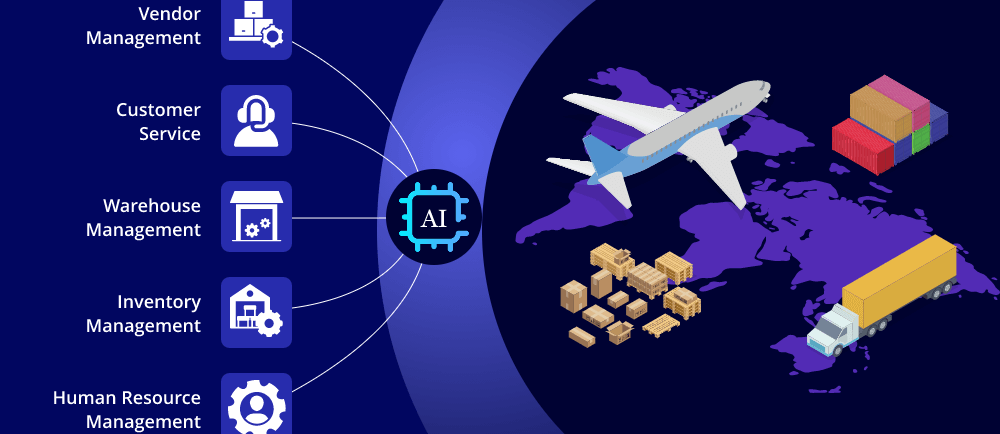INTEGRATING GENERATIVE AI INTO SUPPLY CHAIN MANAGEMENT
Integrating AI into supply chain landscape is one of the most innovate avenue to drive value and revolutionize operations.
fafure david
1/7/20256 min read


Integrate ChatGPT into your supply chain
If we say supply chains run on data, then with Generative AI -- they fly. Generative AI is a disruptive innovation that's shaking up the supply chain landscape, so we all need to understand how it's going to affect us.
Artificial intelligence is revolutionizing the way we get work done in our supply chains today. A lot of the tasks that people do manually, could be done better, faster, and cheaper using AI tools like ChatGPT – leading to more efficiency, we just have to understand how these tools work. ChatGPT is one of several AI products from a company called OpenAI. Technically, ChatGPT is a type of artificial intelligence called a large language model or LLM. It works as a chat engine. That means you engage in asking questions - prompts and it compiles information from a huge database, responds to your prompt with an answer. You keep the back and forth prompting until you come up with a convincing response, remember that these answers might not be 100% correct, so they might need some filtering to avoid inaccuracy or plagiarism. There are lots of AI tools in the market and new ones are appearing every month. All of them have strengths and weaknesses.
How is generative AI a big deal in supply chain operations and promote efficiency?
Let’s create the illustration to establish the relationship between people and computers using a model called the information value chain -- A phone number is a piece of data, so is a person's name. By itself, that data isn't very useful, but that data becomes valuable when we start to organize it. When we create a relationship between a name and a phone number, you know that this is the number to call to reach a certain person. Creating that relationship transforms the data into information, and you can use information to make decisions and take action. Once we have information, we can organize it by filtering and sorting it. This helps us look for patterns and makes it easier to find things quickly. Then the information becomes knowledge. As we create relationships between the things that we know, we can start to apply intuition and develop judgment. In other words, we convert knowledge into wisdom.
Now, bringing this to the tasks that we perform in a supply chain. We create production schedules, place orders with suppliers, book transportation, and a lot more. Some of these tasks just involve collecting and processing data. Most people agree that these tasks should be automated because computers are better at that kind of work than people are. As we move into tasks that involve making decisions, taking action, and using judgment, people are generally better at those tasks, and somewhere in the middle, there's always a handoff between people and machines. A human-machine interface that allows them to communicate with each other. Generative AI has changed the curve for computers and the human machine interface is moving further to the right. As that happens, more and more of the tasks that we do in a supply chain become targets for automation. It's a great example of digital transformation in the supply chain. It's what happens as new technologies allow computers to do tasks better than people, and in order to stay competitive, we need to learn how to adopt those technologies as they emerge, and we need to be strategic about which tasks we choose to automate.
Tools like ChatGPT can supercharge your performance, helping you to get more done better and in less time, we've got to try it out and learn how to use it. Though ChatGPT can help us forecast demand, manage inventory, and optimize transportation but we also have to be aware of the challenges. Ethics matter, and there are a lot of risks with this technology. Knowing the pros and cons will help us make the best use of this tech while staying true to our values. ChatGPT is like a bridge between different parts of the supply chain. We can use these tools to boost innovation, fine tune our processes and make our customers happier.
Use generative AI in supply chains
One of the easiest ways to get started with ChatGPT is to use it as a reference tool. It offers quick access to a wide array of supply chain topics, from fundamentals to advanced strategies. Whether you need to understand specific logistics terms, explore inventory management techniques, or find examples of effective supply chain practices, ChatGPT can give you some pretty good information in a hurry.
Use ChatGPT as a chatbot
Customer service is an important job for every business, and it's an important part of keeping a supply chain moving smoothly. We need to provide service to our external customers who have questions about our products and services, and we also need to provide customer service to our internal customers. Just think about how many internal customers our HR and IT departments have to serve. One of the ways that companies are starting to use AI tools like ChatGPT is to enhance service efficiency and quality. By automating responses to common customer inquiries, you can reduce wait times and improve customer satisfaction. ChatGPT's ability to understand and process natural language allows it to handle a wide range of queries from basic product questions to more complex troubleshooting issues.
Use ChatGPT as a supply chain translator
Have you ever had to translate a message or a document into a different language?
One of the major tools out there is the Google Translator or Deep L, but the use of ChatGPT is now getting more prominent. Whether it's translating procurement documents, contracts, or emails, ChatGPT can handle a wide range of languages; which makes communication a lot easier. However, for important documents (especially contracts), you still want to have them reviewed by a professional translator or a native speaker, because AI translations might not capture the full nuance of human languages. But even so, ChatGPT is usually a good place to start.
Use ChatGPT to write code for supply chain
Lots of supply chain jobs involve writing computer code. There might be need to write SQL queries to pull data for analytics, or need to use HTML and JavaScript to create analytics dashboards.
Use ChatGPT to write supply chain content
Have you ever been stuck writing a memo, wondering how to phrase things just right? Or maybe you've spent way too much time drafting an email that should have been simple. Well, ChatGPT can help write memos, emails, and even content for our websites and social media. ChatGPT can also assist in writing marketing materials based on the level of instructions given.
Maximize the supply chain benefits of generative AI
As supply chain professionals, we think about risk a lot. And when using an AI tool like ChatGPT, there are some important risks that we need to consider.
1. Accuracy: While ChatGPT provides information quickly, the accuracy of the information can vary. It's essential to verify the data, especially when making critical business decisions.
2. Credibility: ChatGPT generates responses based on a vast pool of information, but we must be mindful of the sources of these information, for detailed research or reports, it is better to trace information back to its original source.
3. Plagiarism: The content produced by ChatGPT should be checked for originality. Ensuring that the content is original is both very important and really hard to do. This has generated huge concern in universities.
4. Finally, we need to think about intellectual property and data privacy. Inputting sensitive or proprietary information into ChatGPT contributes to the AI training data model and will actually change future outputs, not just for you, but potentially for all ChatGPT users.
Manage the risks of generative AI in the supply chain
If you are in the field of supply chain you will want everything done better, faster, and cheaper. AI tools like ChatGPT offer real benefits because they can make us more efficient and more effective.
First, they provide rapid access to a vast range of information which can help with research and decision making. This is valuable because supply chain management is such a broad field involving procurement, logistics, operations, and more.
Second, AI tools can automate routine tasks such as drafting emails or generating reports, and that allows us to focus on more strategic aspects of our work.
Third, AI tools can also assist in complex problem solving by offering data-driven insights and innovative solutions to supply chain challenges.
And, AI tools can facilitate better communication and collaboration within teams, and with external stakeholders while streamlining workflows and reducing the likelihood of errors used. Well, AI tools like Chat GPT augment the capabilities of supply chain professionals, and that translates into better operational efficiency and decision making up and down the supply chain.
credit: Daniel Stanton
Expert in Supply Chain Strategy and Project Management
